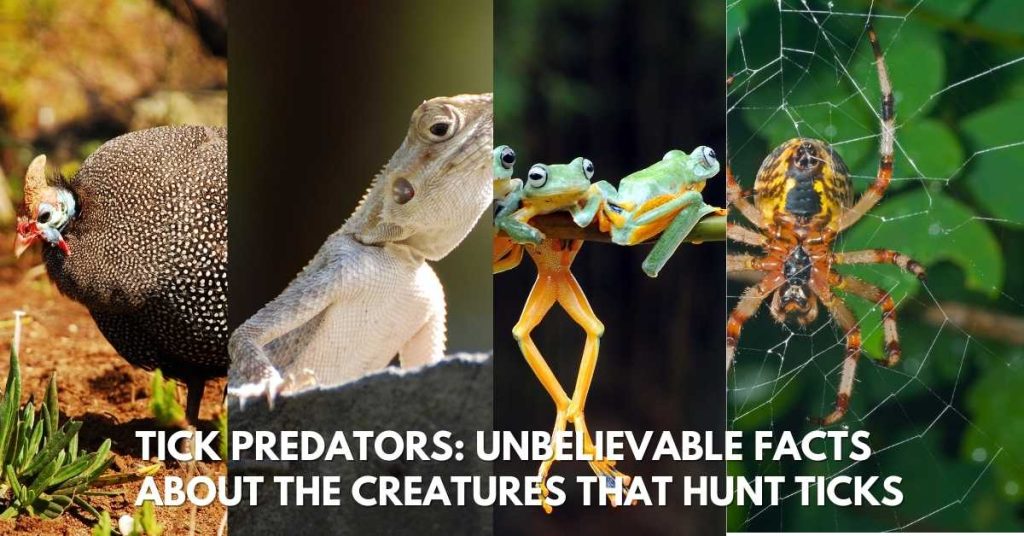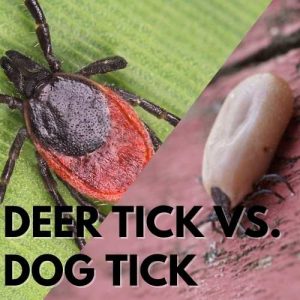
Ticks are pesky little insects that can transmit diseases. One of the best options to get rid of ticks is by having natural predators on your property, which will eat ticks. Do you know what eats ticks? If you don’t, you’re not alone. Most people have no idea what preys on these pesky little bloodsuckers.
Learn about some of the fascinating facts about tick predators. You will be astonished at the creatures that hunt these pests.
Tick Predators: An Overview
Some are large mammals, while others are tiny insects. Some tick predators are even members of the bird family. Whatever their size or shape, all tick predators have one thing in common: they help to keep the tick population under control.
One of the most interesting facts about tick predators is that they often target species of ticks. For example, the opossum is a well-known predator of the deer tick, which is known to carry Lyme disease. Similarly, the meadow vole is known to prey on the black-legged tick, another species that can transmit Lyme disease to humans.
While most predators target adult ticks, some will also eat tick larvae and nymphs. That is especially important as it can help prevent disease spread. For example, the American robin eats adult ticks and larvae.
So, the next time you discover a tick on your pet or yourself, remember that there are creatures out there that prey on these pests. While they may not be able to completely eliminate the tick population, they play an important role in keeping it under control.
Tick Predators: Most Common Predators That Eat Ticks
Did you know that over 850 different animal species consume ticks? That’s right – many different types of creatures help control tick populations, from lizards to badgers to opossums. Studies have shown that areas with a higher density of predators have fewer ticks.
There are a few reasons why predators help keep tick populations in check. First, predators eat ticks and consume the pathogens that the ticks may carry. It reduces the likelihood of transmitting those pathogens to other animals or humans. Second, by eating ticks, predators reduce the overall population of ticks in an area. That, in turn, reduces the likelihood of people and animals coming into contact with ticks.
A few different types of predators are particularly effective at reducing tick populations. These include:
- Lizards: These are voracious eaters who consume just about anything – including ticks. One study found that lizards can consume up to 95% of the ticks in an area.
- Badgers: Badgers are another excellent tick predator. These burrowing animals often create dens in areas with high populations of ticks – meaning they can assist in lowering the number of ticks in these areas.
- Opossums: Opossums are an effective tick predator. These marsupials are known to eat up to 5000 ticks per season.
- Chipmunks, squirrels, mice, and small rodents: These animals eat ticks and are much more effective in controlling ticks.
- Frogs: Toads and frogs are two surprising amphibians that eat almost any insect, including ticks. Sometimes female ticks serve as bait to catch them – though not always. Since these creatures mostly live in water, they do not frequently come in contact with ticks. However, when the frogs and toads are in a close encounter, they avariciously eat them.
- Chickens: Chickens are common livestock that many people keep in their homes. The birds search for food on the ground and eat insects when they come across them, so ticks fall prey to these hungry fowl.
- Guineafowl: The guinea fowl is a native African bird that belongs to the same family as peacocks. They feed on insects like ticks and stunningly pick these tasty morsels off the ground easily.
- Wild turkeys: These birds also hunt ticks and help control the tick population.
- Snakes: Snakes are another common type of tick predator. These predators hunt using their sense of smell to locate ticks hidden in vegetation. Once a snake has found a tick, it will use its sharp teeth to puncture the tick’s body and inject venom. This venom quickly paralyzes the tick, allowing the snake to eat it.
- Spiders: Spiders are also effective predators of ticks. These creatures spin webs that trap ticks that are looking for a host. Once the spider has captured a tick in its web, it will quickly wrap the tick in silk and then inject it with venom. The venom of a spider is very powerful and can kill a tick within minutes.
- Birds: Another type of predator that feeds on ticks. These creatures use their sharp beaks to puncture a tick’s body and consume the blood inside. Birds that hunt ticks typically live in areas with high populations of these parasites.
- Mammals: These creatures typically hunt using their sense of smell to locate ticks hidden in vegetation. Once a mammal finds a tick, it will use its teeth to remove it from its body. This method effectively prevents the mammal from becoming infected with diseases carried by the tick.
As you can see, many different types of animals help keep tick populations in check. By understanding predators’ role in controlling tick populations, we can more effectively prevent the spread of disease.
Tick Predators Can Help Control Tick Populations
Predators can help control tick populations and protect humans and animals from diseases. There are several natural predators, including spiders, reptiles, and even some birds. Predators help keep tick populations in check by eating adult ticks and larvae. It helps to reduce the number of ticks that can mature and reproduce. As a result, predators can play an important role in controlling tick populations and protecting people and animals from disease.
If you reside in a region with a high tick population, you may want to consider introducing some of these tick predators into your environment.
Role Of Tick Predators In Preventing Tick-Borne Illnesses
Tick predators play an important role in preventing tick-borne illnesses. Here are five amazing facts about the creatures that hunt ticks:
- Ticks are attracted to the smell of blood, and many predators have a keen sense of smell that allows them to locate and eat ticks.
- Some tick predators, like the opossum, have a special ability to kill ticks. Studies have shown that opossums can kill up to 96% of the ticks they come in contact with.
- Tick predators help to keep the populations of disease-carrying animals in check. When predators eat infected animals, they help prevent disease spread.
- Tick predators can also help control the insect populations that carry diseases. When predators eat ticks, they also eat the insects that the ticks feed on.
- Tick predators play an important role in our ecosystem and should be protected. We need to do everything we can to protect these amazing creatures.
Are The Natural Tick Predators Effective?
Lyme disease, a bacterial infection spread by ticks, has increased in recent years. As a result, interest has been reignited in tick predators, such as bats, lizards, and birds. These animals naturally prey on ticks, and it is thought that they can help reduce ticks’ overall population. However, there is yet a great deal of debate about the effectiveness of these predators.
Some experts believe that the number of predators needs to be increased significantly to make a dent in the tick population. Others argue that these animals are not particularly efficient at targeting ticks and that their impact is minimal. The panel is still out on this issue, but it is clear that more research is needed to determine how natural tick predators can play in controlling the spread of Lyme disease.
Predators can help to keep tick populations in check without resorting to harsh chemicals. However, it’s important to note that most predators only eat adult ticks. As a result, they can only do so much to control the overall population. In addition, these predators may not be suitable for all areas due to climate or terrain. For example, guinea fowl require warm weather and open spaces to thrive. As a result, they may not be an effective solution in more northern regions. Ultimately, natural predators can play a role in controlling tick populations but should use them in conjunction with alternate ways.
Benefits Of Tick Predators
There are many benefits to having these predators around, including reduced disease transmission, reduced populations of ticks, and improved public health. Each of these benefits is extremely important in the fight against tick-borne diseases.
- Reduced disease transmission is one of the most important benefits of having these predators around. When these predators eat ticks, they are preventing the ticks from being able to transmit diseases to humans and other animals. That is extremely important in areas where tick-borne diseases are common.
- Reduced populations of ticks is another benefit of having these predators around. When these predators eat ticks, they reduce the overall population of these parasites. It can help to prevent outbreaks of tick-borne diseases and improve public health.
- Improved public health is the final benefit of having these predators around. When these predators eat ticks, they improve the area’s overall health. It is because fewer ticks mean there will be less disease transmission. It can help to improve the quality of life for people living in areas with high populations of ticks.
Do Ticks Defend Themselves?
Ticks are not known to be very good at defending themselves. They are quite vulnerable to predators. Many animals will hunt and eat ticks. Ticks have very few defenses against predators. They don’t have any venom, and their hard exoskeleton makes them difficult to digest. It means that they are often eaten alive.
Ticks are tiny arachnids that feed on the blood of animals and humans. Although they are often considered pests, ticks play an important role in the ecosystem by serving as a food source for many animals. In addition, ticks help to control the population of other animals by transmitting diseases. However, ticks are also at risk of being eaten by predators. Ticks have several adaptations to defend themselves, making them difficult for predators to consume.
Ticks have a hard exoskeleton that protects them from being crushed. In addition, their legs are equipped with barbs that make it difficult for predators to remove them from their host. Ticks also secrete a chemical that makes them taste unpleasant, deterring predators from eating them. As a result of these adaptations, ticks can effectively defend themselves from most predators.
The Takeaway
While you may be unable to control the environment in which ticks live, you can take precautions to protect yourself, your family members, and your pets from these blood-sucking parasites. By using tick prevention methods and being aware of the predators that hunt ticks, you can bring down your risk of exposure to Lyme disease and other tick-borne illnesses.



